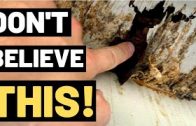Roof Repairs – Stop and Prevent Leaky Shingles and Vents – Do It Yourself
Base flashing for reference: https://amzn.to/2AFZZx6 and https://amzn.to/2A10NwK
Due to requests, I am now including links to products when possible. These links are provided for reference, no company or individual paid to be in this video. Depending on the vendor, a small commission might be paid and would be used to support adding content to this channel.
Amazon Prime free 30 day trial: https://amzn.to/3g9mwCL
Before you get on the roof and begin doing some repair work, make sure you follow the basics of safety.
First, place your ladder in a location that will provide for the minimum amount of climbing. There’s no need to climb to a high roof point on the front of the house if there’s a much lower spot right around the corner. Second, make sure your ladder is big enough. If getting up on the roof means you’ll have to put a foot on that last step, stop and go get another ladder – maybe even an aluminum extension ladder as we did. And finally, if it’s at all possible, ask someone on the ground to hold the ladder for you while you get up and down.
One of the best things you can do to avoid having to repair your roof is simple preventative maintenance. Ideally, you should perform semi-annual inspections to identify and solve problems as they occur. Roofs get more abuse from the elements than any other part of the building, and preventative maintenance is a key element to saving money on your roof by providing a longer service life.
Clean all debris from the surface of the roof. This includes debris that has gathered behind HVAC units, pipes and pitch pans, and any other roof penetrations. Debris has a tendency to hold water, and water will cause the roof to deteriorate much faster than it otherwise would, especially if your roof is asphalt based such as a built-up roof or asphalt shingles. If your roof is starting to collect moss or algae, install some zinc or lead control strips.
Here are some other roof repair maintenance ideas. Dab some roof cement under any loose shingle tabs. One dab on either side should do. Replace any damaged shingles.
Keep all gutters free of debris. Make sure that the downspouts are draining properly by water testing them and trim back any overhanging tree branches.
You might also check the flashings. The function of flashings is to provide a watertight junction between roofing materials and roof projections or other parts of the structure, and between roof sections. Many early roof problems are actually flashing problems. Often, repairing the flashings or providing new flashings is all that is needed to make the roof watertight again.
Most flashing problems result from inadequate flashing design or faulty construction. Flashings should be designed to furnish service for at least as long as the materials used in the field of the roof. Flashings are the most vulnerable part of any roof. Their importance and the importance of maintaining them properly cannot be overemphasized.
In many instances, leaks occur at flashings where there are no flashing defects. These leaks may be the result of open joints in a masonry wall or coping cap, which permits water to enter behind the flashings and into the building. This problem may be eliminated by “through-wall” flashings.
Beyond maintenance, if you need help on any specific roofing problem, ask for advice at your local hardware store or home center – or try looking for information on-line. Remember, every home has a roof, and if yours has a problem, the odds are that someone else has had the problem before and is ready to help with the knowledge and tools to get your home the shelter it needs.
MORE FROM YOUR NEW HOUSE
Featured videos:
Great DIY Projects from Your New House:
Quick Tips – easy tips to make your projects (and life) better:
Gardening and Landscaping:
Adventures in Homebuilding – Home info with a smile:
Choosing and Using Tools with Carmen Ciricillo:
Factory Tours and Product Testing:
Al Carrell – The Super Handyman:
The Great Outdoors with Joe Sherinski:



























